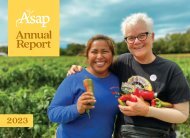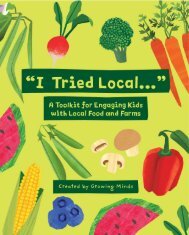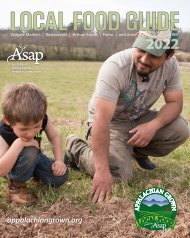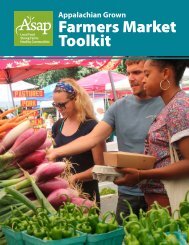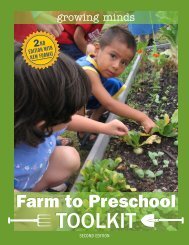2023 Local Food Guide
ASAP’s annual Local Food Guide is the definitive resource for local food in Western North Carolina and the Southern Appalachians. Find hundreds of listings for family farms and farmers markets, as well as restaurants, artisan producers, and groceries that feature local food. Connect with farm experiences, like u-pick, farm stands, lodging, and more.
ASAP’s annual Local Food Guide is the definitive resource for local food in Western North Carolina and the Southern Appalachians. Find hundreds of listings for family farms and farmers markets, as well as restaurants, artisan producers, and groceries that feature local food. Connect with farm experiences, like u-pick, farm stands, lodging, and more.
You also want an ePaper? Increase the reach of your titles
YUMPU automatically turns print PDFs into web optimized ePapers that Google loves.
Gwen. “It’s hard work, but it’s<br />
worthwhile—especially when<br />
someone comes back to say<br />
how much they enjoyed eating<br />
mushrooms or that they feel<br />
better after changing their<br />
eating habits.”<br />
Building the Business<br />
Gwen and Jay didn’t set out<br />
to be mushroom growers, but<br />
couldn’t find suitable land for a<br />
conventional farm. They decided<br />
to figure out a niche that would<br />
allow them to make the most<br />
of sloped acreage and subpar<br />
soil. Gwen had been studying<br />
fungal ecology in a PhD program,<br />
so mushrooms seemed like a<br />
good fit.<br />
At first they tried growing with<br />
outdoor logs, but the labor and<br />
materials cost was too high for the<br />
yield. It was also unpredictable—<br />
not conducive to a weekly market<br />
schedule. “Outdoor logs didn’t<br />
make sense to do as more than<br />
a side hustle,” admits Gwen. “It<br />
was important to us that we could<br />
make a living at this.”<br />
Indoor cultivation was a newer<br />
concept, but one they realized<br />
could be more financially viable<br />
for them—even if there wasn’t a<br />
lot of information on how to set<br />
up systems. “It was hard to learn,”<br />
says Gwen. “There are some<br />
people teaching courses, but it’s<br />
mostly on YouTube.” Gwen and<br />
Jay worked off farm in 2017 and<br />
2018 as they built infrastructure,<br />
and in 2019 went full time on<br />
the farm. In addition to farmers<br />
markets, they started selling to<br />
restaurants.<br />
Most of Black Trumpet’s<br />
mushrooms are grown yearround,<br />
but they do swap some<br />
types seasonally. Pink and golden<br />
oysters do better in hotter<br />
weather, whereas king blue<br />
oysters and trumpets do better<br />
in cold. By rotating strains, they’re<br />
able to use less power, keeping<br />
the grow rooms at 58 degrees<br />
in the winter and 65 degrees in<br />
the summer.<br />
Indoor cultivation does create<br />
sustainability tradeoffs with more<br />
power usage and plastic grow<br />
bags, notes Gwen. One way they<br />
work to offset this is by using<br />
sawdust recycled from local<br />
furniture factories as a substrate.<br />
They’re also planning to launch a<br />
compost business this year.<br />
In 2022, after two years of<br />
construction, they completed a<br />
new 2,000-square-foot growing<br />
facility with more advanced HVAC<br />
and solar panels. They estimate<br />
their yield will double, or even<br />
triple, over the next several years.<br />
“We’re up to 1,000 pounds a<br />
week,” says Gwen. “It’s really a<br />
huge difference.” Plus, the new<br />
facility gives them the ability to<br />
grow new species, such as beech<br />
and maitake.<br />
With the increase in production<br />
and new business on the horizon,<br />
they’ve hired several employees.<br />
Gwen and Jay—who had a baby<br />
in January—are moving into<br />
a phase where they can think<br />
beyond the farm’s day-to-day<br />
needs. For Gwen, that’s more<br />
outreach and education.<br />
“It’s been five years of constant<br />
building things ourselves,” she<br />
says. “We made it through the<br />
pandemic, supply chain issues. I’m<br />
happy to see us in a place of more<br />
stability, but I’m ready to stop<br />
building infrastructure and start<br />
building the business.”<br />
appalachiangrown.org <strong>Local</strong> <strong>Food</strong> <strong>Guide</strong> 61





